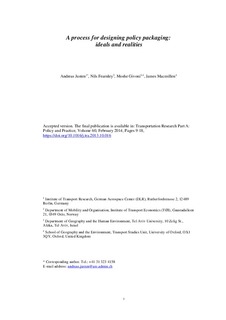| dc.contributor.author | Justen, Andreas | |
| dc.contributor.author | Fearnley, Nils | |
| dc.contributor.author | Givoni, Moshe | |
| dc.contributor.author | Macmillen, James | |
| dc.coverage.spatial | Norway | nb_NO |
| dc.date.accessioned | 2019-06-04T11:47:20Z | |
| dc.date.available | 2019-06-04T11:47:20Z | |
| dc.date.created | 2014-02-07T14:21:12Z | |
| dc.date.issued | 2014-02-06 | |
| dc.identifier.citation | Transportation Research Part A: Policy and Practice. 2014, 60 9-18. | nb_NO |
| dc.identifier.issn | 0965-8564 | |
| dc.identifier.uri | http://hdl.handle.net/11250/2599904 | |
| dc.description | Embargo until 06.02.2016 | nb_NO |
| dc.description.abstract | The article introduces a design process for policy packaging, combining a heuristic approach with a real world example of European policymaking. The policy packaging process is divided into six stages, starting with (1) the definition of goals and objectives, (2) the creation of an inventory of measures, (3) the formulation and assessment of the initial package, (4) the modification of the initial package through adding, adjusting or removing measures, (5) package implementation, and finally (6) the monitoring and evaluation of the package. The process stands as a generic, comprehensive framework developed as a means of guiding policy formulation and increasing the likelihood of efficient, effective and acceptable policy interventions. The approach is compared to practice, examining whether it can support policy formulation in relation to the EU 2011 White Paper on transport. It shows that several principles of the design process are already reflected by the White Paper, with some important differences also observed. While objectives, targets, and an inventory of measures are part of the White Paper, policies recommended for implementation are treated separately as discrete interventions. The White Paper hence lacks examples or recommendations as to how various measures might be combined in order to achieve the policy objectives. Based on a policy example from the White Paper, it is attempted to apply the heuristic framework and offer recommendations on how to best construct a policy package. | nb_NO |
| dc.language.iso | eng | nb_NO |
| dc.publisher | Elsevier | nb_NO |
| dc.rights | Attribution-NonCommercial-NoDerivatives 4.0 Internasjonal | * |
| dc.rights.uri | http://creativecommons.org/licenses/by-nc-nd/4.0/deed.no | * |
| dc.subject | Policy Packaging | nb_NO |
| dc.subject | EU Transport Policy | nb_NO |
| dc.subject | Policy Assessment | nb_NO |
| dc.title | A process for designing policy packaging: Ideals and realities | nb_NO |
| dc.type | Journal article | nb_NO |
| dc.type | Peer reviewed | nb_NO |
| dc.rights.holder | Copyright © 2013 Elsevier Ltd. All rights reserved. | nb_NO |
| dc.description.version | acceptedVersion | nb_NO |
| cristin.unitcode | 7482,0,0,0 | |
| cristin.unitname | Transportøkonomisk institutt | |
| cristin.ispublished | true | |
| cristin.fulltext | postprint | |
| cristin.qualitycode | 2 | |
| dc.identifier.doi | 10.1016/j.tra.2013.10.016 | |
| dc.identifier.cristin | 1110853 | |
| dc.source.journal | Transportation Research Part A: Policy and Practice | nb_NO |
| dc.source.volume | 60 | nb_NO |
| dc.source.issue | Februar 2014 | nb_NO |
| dc.source.pagenumber | 9-18 | nb_NO |
| dc.subject.nsi | VDP::Samfunnsvitenskap: 200 | nb_NO |

